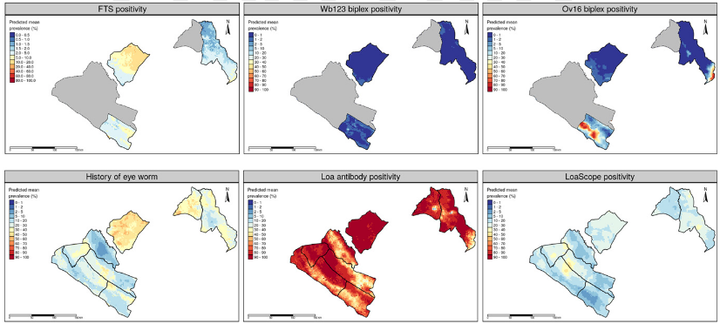An Integrated District Mapping Strategy for Loiasis to Enable Safe Mass Treatment for Onchocerciasis in Gabon
 Predicted mean prevalence of indicators for lymphatic filariasis, onchocerciasis, and loiasis.
Predicted mean prevalence of indicators for lymphatic filariasis, onchocerciasis, and loiasis.
Abstract
The lack of a WHO-recommended strategy for onchocerciasis treatment with ivermectin in hypo-endemic areas co-endemic with loiasis is an impediment to global onchocerciasis elimination. New loiasis diagnostics (LoaScope; Loa antibody rapid test) and risk prediction tools may enable safe mass treatment decisions in co-endemic areas. In 2017-2018, an integrated mapping strategy for onchocerciasis, lymphatic filariasis (LF), and loiasis, aimed at enabling safe ivermectin treatment decisions, was piloted in Gabon. Three ivermectin-naïve departments suspected to be hypo- endemic were selected and up to 100 adults per village across 30 villages in each of the three departments underwent testing for indicators of onchocerciasis, LF, and loiasis. An additional 67 communities in five adjoining departments were tested for loiasis to extend the prevalence and intensity predictions and possibly expand the boundaries of areas deemed safe for ivermectin treatment. Integrated testing in the three departments revealed within-department heterogeneity for all the three diseases, highlighting the value of a mapping approach that relies on cluster-based sampling rather than sentinel sites. These results suggest that safe mass treatment of onchocerciasis may be possible at the subdepartment level, even in departments where loiasis is present. Beyond valuable epidemiologic data, the study generated insight into the performance of various diagnostics and the feasibility of an integrated mapping approach utilizing new diagnostic and modeling tools. Further research should explore how programs can combine these diagnostic and risk prediction tools into a feasible programmatic strategy to enable safe treatment decisions where loiasis and onchocerciasis are co-endemic.